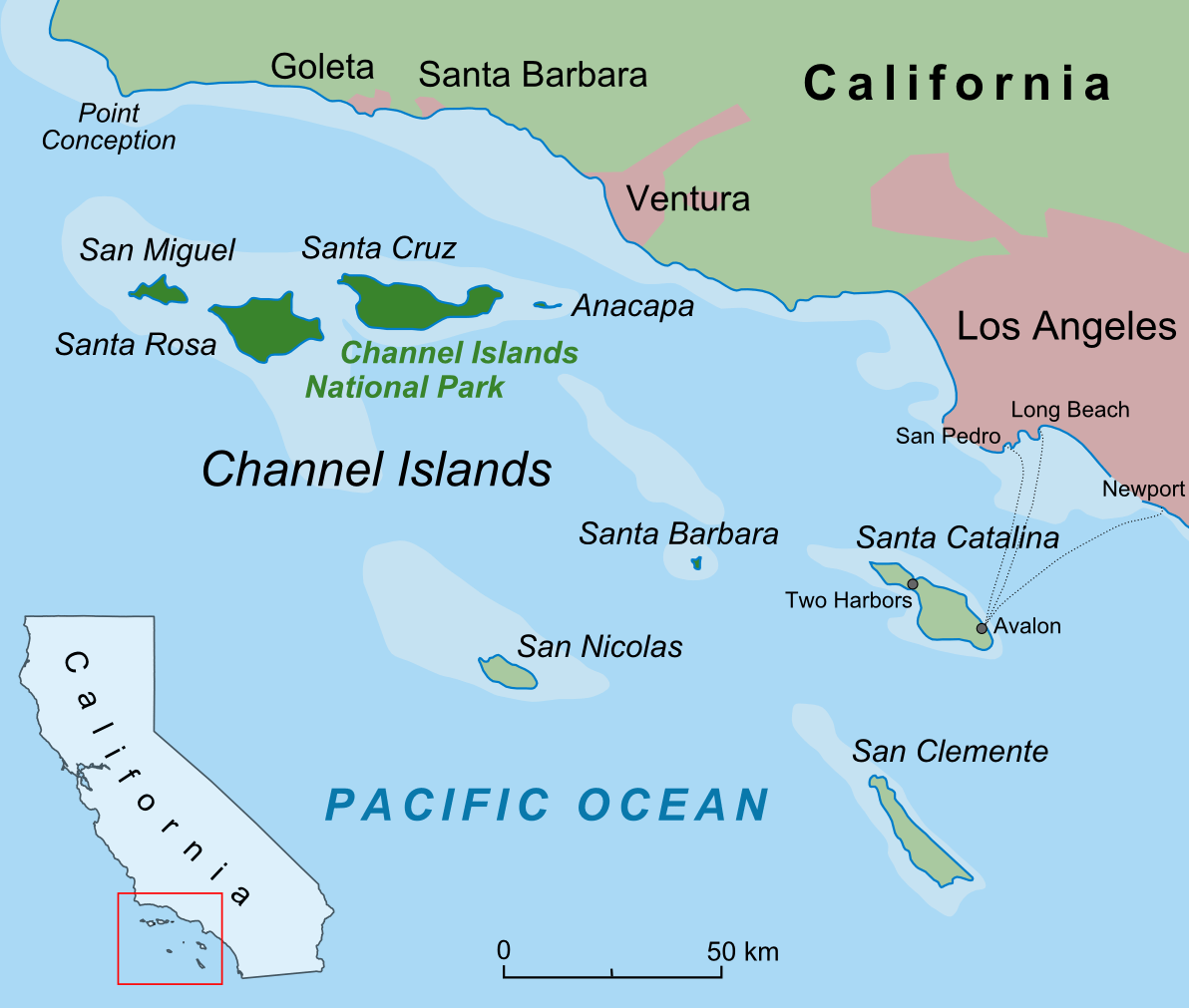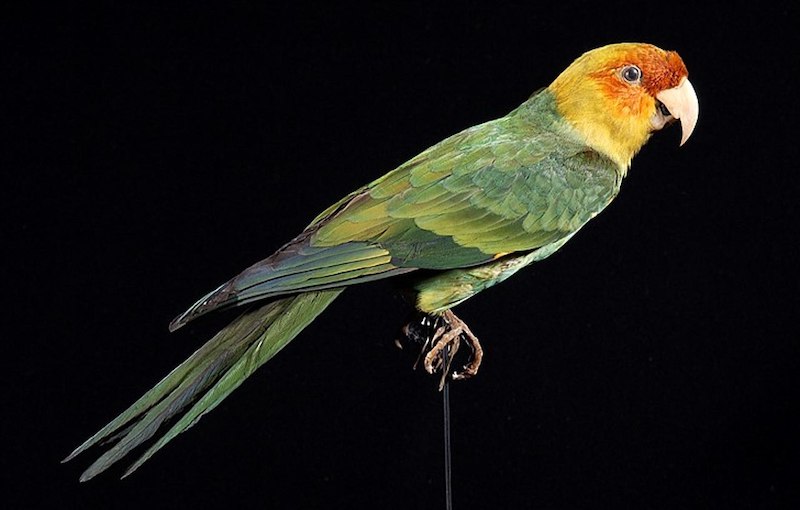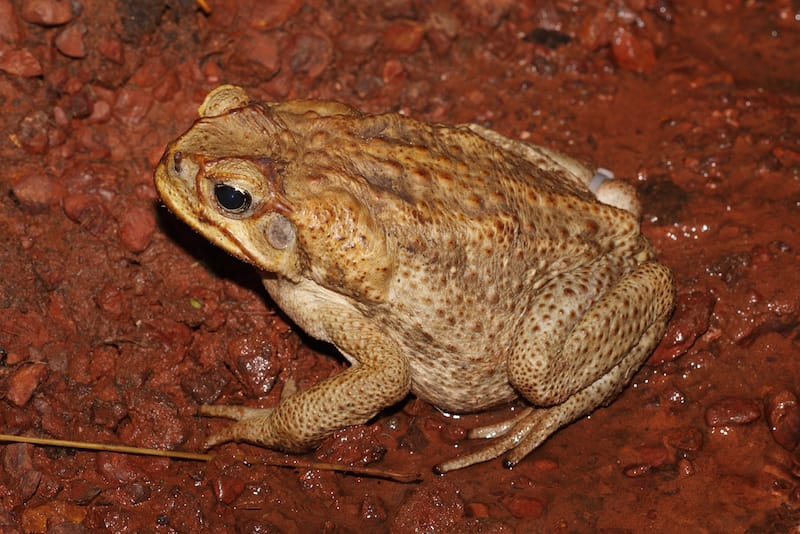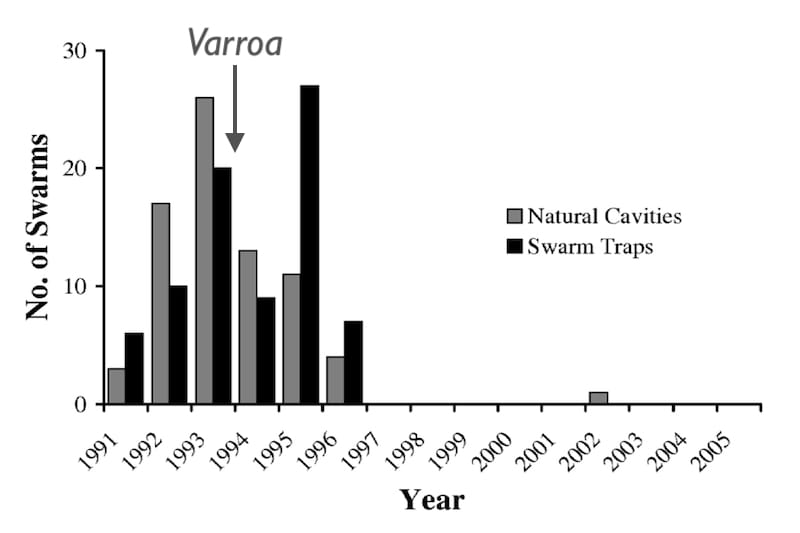Biological control with Varroa
Synopsis : Honey bees were eradicated on Santa Cruz Island following the introduction of Varroa. This provides some useful lessons for beekeepers on the importance of controlling Varroa.
Introduction
Honey bees are not native to North America. They were first introduced in March 1622 at Jamestown, Virginia. The bees did well and spread west, following the settlers. They finally arrived on the west coast, in Santa Clara, California, 231 years later in 1853. Of a dozen hives ordered by Christopher Shelton, a Santa Clara botanist and rancher, only one survived the journey from New York via Panama.
Shelton barely had a chance to enjoy his bees {{1}} as he was unfortunately killed when the steamboat Jenny Lind exploded in mid-April 1853.
His bees survived {{2}} and three hives derived from the original stock were auctioned for $110 each. This was over 20 times the price of hives on the east coast at that time and equivalent to over $4200 today {{3}}.
Bees were in demand and they continued to spread – both as feral swarms and as farmers established apiaries to help pollination and for honey production. Having reached the California coast they were then spread to the nearby islands. Bees were transported to Santa Cruz, the largest of the eight Channel Islands near Los Angeles, in the 1880’s. They flourished, but did not spread to the other Channel Islands.
Field station, nature reserves, pigs and bees
Santa Cruz Island is 250 square kilometres in area and lies ~35 km south of Santa Barbara. It is one of the four Northern Channel islands. There is a long central valley lying approximately east-west and the rocky mountainous land reaches 740 m. It has a marine temperate climate; the average low and high temperatures are 9°C and 21°C respectively and it receives about 0.5 m of rain a year. It is a good environment for bees.
From the 1880’s to 1960’s Santa Cruz Island was farmed – primarily for wine and wool, and from the 1940’s for cattle – but, after period of university geology field trips and the establishment of a field station on the island, in 1973 it became part of the University of California’s Natural Reserve System (UC NRS).
In the late 1970’s the Stanton family sold their ranching business on the island to The Nature Conservancy who subsequently bought additional land on the eastern end of the island.
Santa Cruz Island is now jointly owned by The Nature Conservancy, National Parks Service, UC NRS and the Santa Cruz Island Foundation and much of the island is used for scientific research and education.
But what about the bees?
Good question.
As a nature reserve and research station, the presence of non-native species causes a potential problem. Why go to all the expense of managing a remote island research centre if all the same species are present as on the mainland?
The Nature Conservancy therefore initiated a programme of eradicating non-native species. It took 14 months to eliminate the feral pigs, using a combination of trapping, helicopter-based shooting and the release of sterilised radio-tagged pigs to locate the stragglers {{4}}.
But getting rid of the bees took a bit longer …
Save the bees, or not
Why get rid of the bees? Surely they weren’t doing any harm?
The introduction of any non-native species upsets the balance (if there’s ever balance) in the ecosystem. The introduced species competes directly or indirectly with those native to the area and can lead to local extinctions.
Jonathan Rosen has described {{5}} how honey bee swarms, through occupying tree cavities previously used for nesting, probably played a major role in the extinction of the Carolina parakeet.
Competition between honey bees and native pollinators has been well studied. It is not always detrimental, but it certainly can be. Furthermore, it is probably more likely to be detrimental in a small, isolated, island ecosystem. For example, studies showed that the presence of honey bees dramatically reduced visitation of native pollinator to manzanita blossoms on Santa Cruz Island.
As part of the larger programme of non-native plant and animal eradication on Santa Cruz Island plans were drawn up in the late 1980’s to eliminate European honey bees. The expected benefits were to:
- eliminate competition with native bee species (and presumably other non-bee pollinators, though these rarely get a mention 🙁 )
- reduce pollination of weed species (some of which were also non-native to Santa Cruz Island)
- facilitate recovery of native plant species that were reliant on native bee pollination
- provide a ‘field laboratory’ free from ‘exotic’ honey bees in which comparative studies of native pollinators would be possible
Killer bees
After the plans to eradicate Apis mellifera were approved an additional potential benefit became apparent.
There were increasing concerns about the spread of Africanised honey bees which had recently reached Santa Barbara County. Although there was reasonably compelling evidence that swarms could not cross from the mainland (e.g. none of the other Northern Channel Islands had been colonised by bees) there were concerns that the Santa Ana winds might help blow drones from the mainland.
Had these drones arrived they might mate with the non-native but nevertheless local queens resulting in the spread of the dominant genes for defensiveness and absconding. The resulting swarmy, aggressive Africanised bees would cause problems for visitors and scientists working on the island (as they have for visitors to Joshua Tree National Park).
Although the introgression of African honey bee genes was used as further justification for the eradication it’s not clear whether drones could actually cross 30-40 km of open sea {{6}}.
As an aside, there’s a current project – the amusingly named ’Game of Drones’ – running on the Isles of Scilly investigating whether drones can cross the sea between St Agnes, Tresco, Bryher, St Mary’s and St Martin’s. These are, at most, 11 km apart (northern most tip of St Martin’s to most southerly point of St Agnes) but the individual islands are only separated by 1-2 km. I would be surprised if drones could not cross that distance (at least with a strong following wind).
Killing bees
Adrian Wenner and colleagues set about exterminating the honey bees on Santa Cruz Island (Wenner et al., 2009). The process started in 1988 and ended in 2007, and was divided into four phases:
- 1988-1993 – location and elimination of feral colonies
- 1994-1997 – biological control and colony demise
- 1998-2004 – monitoring residual honey bee activity
- 2005-2007 – confirmation of the absence of honey bees
None of this is ’beekeeping’ – actually it’s the exact opposite – so I don’t intend to dwell in much detail on the work that was conducted. However, the ’94-’97 phase includes some sobering lessons for beekeepers which are worth discussing.
By the end of phase 1 the team had identified the existence (if not the location) of at least 200 colonies and eliminated 153 of them.
Remember, none of these were managed colonies in hives. They were all feral colonies occupying natural cavities in trees or rocks etc. Each colony was found using painstaking bee lining techniques similar to those described in Thomas Seeley’s book Following the Wild Bees.
Once located, nests were destroyed with methyl chloroform and the cavity sealed to prevent it being reoccupied.
Some colonies could not be accessed; in these cases acephate-laced sucrose-honey syrup baits were used. This organophosphate has delayed toxicity for bees, allowing foragers to return to the colony which in due course dies. This approach had been partially successful in eliminating Africanised bees on the mainland (Williams et al., 1989), but baits needed to be be monitored to avoid killing the other insects they attracted.
The scientists also deployed swarm traps (aka bait hives) and destroyed any swarms that moved in.
Together these interventions reduced honey bee numbers significantly – as monitored by regular observations at pollen- or nectar-rich plants – but did not eradicate them.
Let there be mite
Heavy rains in January ’93 washed out roads on Santa Cruz Island, thereby severely limiting travel around the island. In addition, the previous removal of cattle had resulted in the near-uncontrolled growth of fennel which now formed dense, impenetrable thickets.
Bee lining became impossible and the scientists had to invent more devious strategies to eliminate the residual feral colonies.
The approach they chose involved the introduction of Varroa.
Varroa was first detected in the USA in 1987 (in Florida) and became widespread over the next 5-8 years. Up until 1994 the honey bees on Santa Cruz Island were free of the ectoparasitic mite.
It was likely that they would have remained that way … there was no beekeeping on Santa Cruz Island and the location was too remote for bees to cross from the mainland (see above).
Varroa was already known to have a devastating impact on the health of honey bee colonies (Kraus and Page, 1995). It was also known that, other than its native host Apis cerana (the Eastern honey bee), Varroa did not parasitise other bee or wasp species (Kevan et al., 1991).
These two facts – host specificity and damage inflicted – suggested that Varroa could be used for biological control (‘biocontrol’) on Santa Cruz Island.
Biological control
Biological control or biocontrol is a method of controlling pests using natural mechanisms such as predation or parasitism.
The pest could be any living thing – from animals to bacterial plant diseases – present where it’s unwanted.
On Santa Cruz Island the pest was the honey bee.
In other studies (covered in a previous post entitled More from the fungi {{7}} ) biocontrol of Varroa has been investigated.
Control of the pest involves the introduction or application of a biological control agent. The key requirements of the latter have already been highlighted – specificity and damage.
Biological control works well when the specificity is high and the damage is therefore tightly targeted. It can be an abject failure – or worse, it can damage the ecosystem – if the specificity is low and/or the damage is widespread.
The cane toad was introduced to Australia to control infestations of greenback cane beetle (a pest of sugar cane). Cane toads were introduced in 1935 and rapidly spread. Unfortunately, cane toads can’t jump very high and so singularly failed to control the greenback cane beetle which tends to {{8}} stay high up the cane stems.
But it gets worse; cane toads have a very catholic diet and so outcompeted other amphibians. They introduced foreign diseases to the native frogs and toads and – because of the poisons secreted from their skin – harmed or killed predators that attempted to eat them.
Oops.
Vertebrates are usually poor biological control agents as they tend to be generalist feeders i.e. no specificity.
But Varroa is specific and so the damage it causes is focused. The likelihood of ecosystem damage was considered low and so the mite was introduced to the island.
Introduction of Varroa
In late 1993 Adrian Wenner caught 85 foraging bees and, to each one, added a single Varroa mite. The bees were then released and presumably flew back to their colonies … taking the hitchhiking mite with them.
Adult mites – the dark red ones you see littering the Varroa tray after you treat with Apivar – are mated females.
Due to their incestuous lifestyle a single mite is sufficient to initiate a new infestation.
The mated adult female mite parasitises a honey bee pupa and produces a series of young; the first is male, the remainder are female. You’re probably reading this before the 9 pm watershed so I’ll leave it to your lurid imagination to work out what happens next (or you can read all the sordid details in Know your enemy).
The presence of honey bees – determined by successful swarm trapping or field observation at likely sites – was then regularly monitored over the next four years.
Swarm numbers remained largely unchanged until 1996 and then dramatically decreased.
It’s worth noting that during ’94-’96 over 70 swarms were found in natural sites or bait hives. There must have been a significant number of established colonies in 1993 to produce this number of swarms.
But, from 1997 it all stopped … only a single swarm was subsequently found, in a natural cavity in 2002.
Monitoring and confirmation of eradication
From 1998 to 2004 the scientists continued to actively monitor the island for honey bees, focusing on 19 areas rich in natural forage. Although honey bees were found – in decreasing numbers – there were too few to attempt bee lining to locate their colonies.
At the sites being monitored, bees were detected 9, 7, 4, 2 and 1 times respectively in the 5 years from 2000 to 2004. After that, despite continued monitoring, no more honey bees were detected.
The final phase of the project (’05-’07) confirmed the absence of honey bees on Santa Cruz Island.
Whilst, as a scientist, I’m a firm believer that ’absence of evidence does not mean evidence of absence’, as a beekeeper I’m well aware that if there are no scout bees, no swarms and no foragers (when I search in likely places) then there are no honey bee colonies.
Lessons for beekeepers
I wouldn’t have recounted this sorry tale – at least from a beekeeping perspective – unless I thought there were some useful lessons for beekeepers.
There are (at least) three.
The first relates to Varroa resistance, the second to Varroa transmission in the environment and the last to ‘safe’ levels of Varroa. All require some ‘arm waving guesstimates’ {{9}}, but have a good grounding in other scientific studies.
Varroa resistance
There wasn’t any.
At a very conservative estimate there were at least 20 colonies remaining on Santa Cruz Island in 1995. I say ‘conservative’ because that assumes each colony generated two swarms that season (see graph above). In studies of other natural colonies only about 75% swarm annually, meaning the actual number of colonies could have been over 50.
The numbers – 20 or 50 – matter as they’re both much higher than the number of colonies most beekeepers manage (which, based upon BBKA quoted statistics, is about 5).
Whether it was 20 or 50, they were all eliminated following the introduction of 85 mites. Colonies did not become resistant to Varroa.
This all took a few years, but – inferring from the swarm numbers above – the vast majority of colonies were killed in just two years, 1994 and 1995. This timing would fit with numerous other studies of colony demise due to mites.
Wenner estimates that only 3 colonies survived until 2001.
Leaving small numbers of colonies {{10}} untreated with an expectation that resistance – or even tolerance (which is both more likely and not necessarily beneficial) – will arise is a futile exercise.
I’ve discussed this before … it’s a numbers game, and a handful of colonies isn’t enough.
Varroa spread
Wenner doesn’t elaborate on where the foragers were captured before he added the mites. If I was going to attempt this I’d have chosen several sites around the island to ensure as many feral colonies as possible acquired mites … let us assume that’s what he did.
However, with 85 mites piggybacking on returning workers, and somewhere between (my guesstimated) 20 to 50 colonies, I think it’s highly likely that at least some colonies received none of this ’founding’ mite population.
Yet almost all the colonies died within two years, and those that did not subsequently died with no further intervention from the scientists. We don’t know what killed off the last surviving colonies but — and I know I’m sticking my neck out here – I bet it was the mites.
This is compelling evidence for the spread of Varroa throughout the island environment, a process that occurs due to the activities of drifting and robbing.
If a neighbouring apiary to yours has mites some will end up in your hives … unless you are separated by several kilometres {{11}}.
The transmission of mites in the environment is a very good reason to practice coordinated Varroa control.
One mite is all it takes
But, just as I’ve argued that some colonies may have received none of the founding mites, I’m equally sure that others will have acquired very small numbers of mites, perhaps just one.
And one mite is all it takes.
Without exceptional beekeeping skills, resistance in the bee population or rational Varroa control {{12}} there is no safe level of mites in a colony.
The more you prevent mites entering the colony in the first place, and the more of those that are present you eradicate, the better it is for your bees.
Here endeth the lesson 😉
Note
It’s worth noting that island populations do offer opportunities for the development of Varroa resistant (or tolerant) traits … if you start with enough colonies. Fries et al., (2006) describes the characteristics of the 13 surviving colonies on Gotland after leaving about 180 colonies untreated for several years. I’ve mentioned this previously and will return to it again to cover some related recent studies.
References
Fries, I., Imdorf, A. and Rosenkranz, P. (2006) ‘Survival of mite infested (Varroa destructor) honey bee (Apis mellifera) colonies in a Nordic climate’, Apidologie, 37(5), pp. 564–570. Available at: https://doi.org/10.1051/apido:2006031.
Kevan, P.G., Laverty, T.M. and Denmark, H.A. (1990) ‘Association of Varroa Jacobsoni with Organisms other than Honeybees and Implications for its Dispersal’, Bee World, 71(3), pp. 119–121. Available at: https://doi.org/10.1080/0005772X.1990.11099048.
Kraus, B. and Page, R.E. (1995) ‘Effect of Varroa jacobsoni (Mesostigmata: Varroidae) on feral Apis mellifera (Hymenoptera: Apidae) in California’, Environmental Entomology, 24(6), pp. 1473–1480. Available at: https://doi.org/10.1093/ee/24.6.1473.
Wenner, A.M., Thorp, R.W., and Barthell, J.F. (2009) ‘Biological control and eradication of feral honey bee colonies on Santa Cruz Island, California: A summary’, Proceedings of the 7th California Islands Symposium, pp. 327–335. Available as a PDF.
Williams, J.L., Danka, R.G. and Rinderer, T.E. (1989) ‘Baiting system for selective abatement of undesirable honey bees’, Apidologie, 20(2), pp. 175–179. Available at: https://doi.org/10.1051/apido:19890208.
{{1}}: Remembering these were for honey and wax production, not enjoyment!
{{2}}: They weren’t on the boat.
{{3}}: Which makes my nucs look like bargains.
{{4}}: Hello friend … bang!
{{5}}: Unfortunately behind a paywall … a bargain at $1 for 6 months.
{{6}}: Let alone then still have the strength to mate.
{{7}}: An entirely predictable pun if you’ve ever seen Paul Stamets talk.
{{8}}: Sensibly.
{{9}}: You’d be disappointed if they didn’t.
{{10}}: Say below a few hundred.
{{11}}: And UK apiary density is usually too high to have that luxury of isolation.
{{12}}: I’ve done a lot of beekeeping and consider the last of these to be the most reliable and certainly easiest to achieve … and it’s what I do.






Join the discussion ...